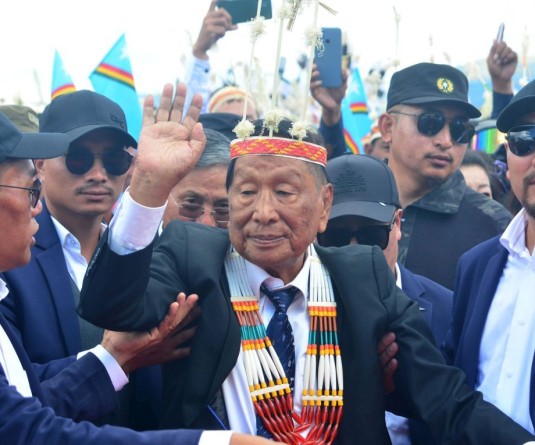Nagaland Chief Minister Dr Neiphiu Rio virtually inaugurates 51 school infrastructure projects under Samagra Shiksha on August 2. (Photo Courtesy: X)
.jpg)
Kohima, August 2 (MExN): In a move to strengthen the education sector in Nagaland, Nagaland Chief Minister Neiphiu Rio on August 2 virtually inaugurated 51 school infrastructure projects funded under the Samagra Shiksha scheme.
The virtual inauguration ceremony was held at the Chief Minister’s Residential Complex in Kohima. Addressing the event, the CM said the inauguration marked a significant step in the state’s ongoing efforts to bolster educational infrastructure, and extended his gratitude to the Government of India for its continued support.
He commended the efforts of the Samagra Shiksha team led by the State Mission Director, L. Jamithung Lotha, and expressed concern that many school infrastructures in the state remained temporary. “There is an urgent need for permanent structures with quality workmanship,” he stated.
Appreciating the Department of School Education for constant improvements despite various challenges, the Chief Minister urged the department to conduct a comprehensive study to assess and highlight its needs and requirements.
“Despite the difficult geographical terrain of the state, especially the remote parts, the state is making consistent progress to transform the infrastructures,” Dr. Rio said. He stressed the importance of community participation and stated, “Good infrastructure alone is not enough,” calling on communities to take ownership of government-provided facilities to ensure proper maintenance and effective utilisation.
He further stated, “It is at the core of development, which empowers the citizens, drives economic progress, opens up opportunities and makes a society prosper.” He called for collective efforts to create a “safe, inclusive, and nurturing environment” for students’ holistic development.
Advisor for School Education and SCERT, Dr. Kekhrielhoulie Yhome, while speaking at the programme, informed that of the 16,087 rooms across government schools, 13,767 rooms or 86% are used for instructional purposes. The rest serve as laboratories, libraries, and teachers’ rooms, among others.
He noted that these rooms are categorised into four groups: those in good condition, those requiring major repair, those requiring minor repair, and those deemed dilapidated. Dr. Yhome added that schools were also classified into pucca structures, partially-pucca structures, and kutcha structures.
He said that funding under Samagra Shiksha had been instrumental in addressing the need for school buildings. Highlighting the Department’s goals under the Viksit Bharat mission, the Advisor said, “Our goal is to bring back about one lakh students to their school system by 2030,” which he added would improve livelihoods and provide financial relief. He expressed hope that improved infrastructure would lead to increased enrolment in government schools.
In his introductory address, State Mission Director L. Jamithung Lotha, NCS, provided an overview of Samagra Shiksha, calling it an “overarching scheme for school education from pre-primary to secondary level, which is LKG to class XII.” He noted that it integrates previous schemes such as the Sarva Shiksha Abhiyan (SSA), Rashtriya Madhyamik Shiksha Abhiyan (RMSA), and Teacher Education (TE), in accordance with the National Education Policy 2020.
Lotha highlighted key interventions under the scheme, including school infrastructure development, provision of free textbooks and uniforms, teachers’ training, and smart classrooms. He said the state had made “substantial strides in addressing the schooling system over the years,” while also raising concerns and challenges in implementation.
Delivering the vote of thanks, Commissioner and Secretary for School Education and SCERT, Kevileno Angami, expressed appreciation to the Chief Minister for his guidance and continued support. She also acknowledged the contributions of all those involved in the successful execution of the projects.
The inaugurated infrastructure includes 15 new school buildings, additional classrooms in 17 schools, 18 teachers’ quarters, and one residential hostel, spread across various districts in the state.
The event was also attended by MLA A. Pongshi Phom, Commissioner and Secretary to the Chief Minister Mohammad Ali Shihab, IAS, and officials from various line departments.





